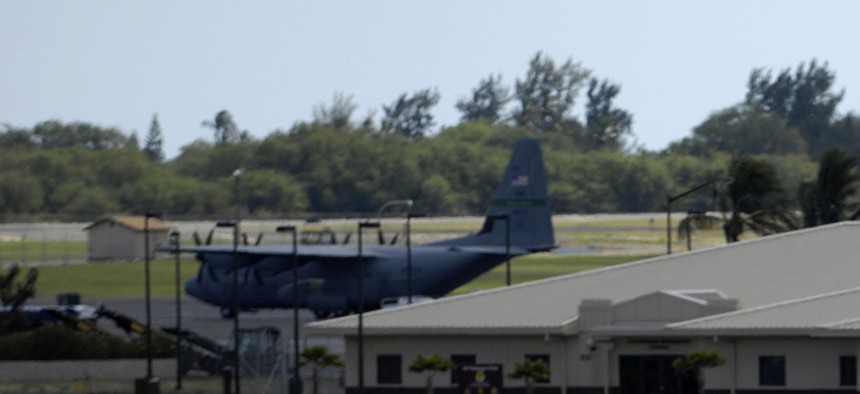
F-22 Raptors with the 27th Fighter Squadron sit on the flightline at Hickam Air Force Base, Hawaii. U.S. Air Force photo by Tech. Sgt. Shane A. Cuomo
If the Pentagon Buys Less, It Needs to Invest More
If the military is supposed to use the peace to prepare for the next war, it has to spend more on research & development. By Gen. Norton A. Schwartz and Col. Tom Harrison
The United States defense budget is in transition, adjusting to new realities following more than a decade of war. As we have observed in past drawdowns, typically the first casualty of peace is Pentagon spending on research, development, test and evaluation, known as RDT&E. This is inevitable: spending is protected for military personnel needs, buying legacy weapons already in production, and to fund sustainment programs – but research and development typically pays the bill, and that is unfortunate.
The military is supposed to use peace to prepare for the next conflict. Developing new technology is fundamental to that job. The Defense Department, however, is pleading for industry to invest more in military R&D. These pleas are, on their face, reasonable enough. Major defense contractors routinely spend less than 2 percent of their revenues on self-funded R&D, a fraction of typical private sector R&D spending. Increasing such spending would be important for military services struggling to keep their technological edge.
But DOD should realign its rules and policies with its preferences. Most companies spend money to make money. In the current defense acquisition environment, private investment on developing new and better military products and processes is simply risky, because it may never be rewarded.
Congress is currently considering suggestions for improving the acquisition landscape in the Department of Defense. Revisiting the treatment of so-called internal research and development, or IR&D, in particular, would be beneficial and timely.
Imagine a company executive trying to build a business case for the multi-year development of a product line with valuable military applications. That executive soon discovers that DOD guidance for internal research and development discourages such investments. Any such costs incurred in any prior year are flatly unallowable, subject to a very narrow exception. Conversely, if such an expense were allowed, it would be treated just like money spent on material used in product manufacture, i.e., it could be charged to a program and recovered on a one-time basis.

The private sector views risky R&D expenditures as investments to create a technological asset. Companies hope to earn a return on the investment by winning a lucrative defense contract. For most suppliers, particularly specialty houses, in fact, a “lucrative defense contract” is an oxymoron. The Pentagon’s latest review of its buying practices, released in June, shows that private sector capital goods manufacturers have average operating margins 50 percent higher than those of defense contractors. Is this a promising sector in which to invest risk capital? Adjusting the negotiated profit margin is no answer. The realistic delta between an average margin and a high margin contract for hardware is around 4 percent of contract value. According to the Defense Acquisition University, the development expense of a military product may easily represent up to 30% of total revenues from the sale of that product. It seems clear that a more robust incentive is needed.
What to do? Imagine if the Pentagon reduced its reliance on cost-based pricing. The gold standard of pricing fairness is competition, not cost. A private sector company may invest in products or processes to win a competition, then earn profits adequate to justify that investment through its innovation. In doing so, the company hopes to attract capital and skilled employees to provide a reasonable return to investors. Too often, however, the acquiring authority relies on sole source award with cost-based pricing, regardless of the potential savings of alternate private sector technologies. This seems to be the central complaint of SpaceX over the Defense Department’s sole source award to Boeing and Lockheed Martin’s United Launch Alliance, or ULA, for 36 launches.
When competition is genuinely infeasible, costs are not the only alternative. The regulations also recognize price analysis, i.e., comparing the offered price to prices previously paid by governments and others for the same or similar products. This approach is especially suitable when the contractor has self-funded development. Getting good value, i.e., a better product at a better price, is what buyers seek when they go to market. In short, reflexively trying to squeeze margins for the lowest possible price discourages contractors from investing in product development.
When costs are truly the only pricing option, contracting officers must have the tools for encouraging self-funded development. If a contractor’s development effort yields a product that uniquely meets the Defense Department’s needs, it deserves a meaningful reward.
Material price allowances specifically designed to recognize self-funded development would start to send the messages that industry needs to hear if it is to heed the calls for more such development. Defenders of the status quo will protest that some contractors might be overpaid. Perhaps, but DOD has hardly seen bargains when undertaking its own development programs. At least mistakes of this kind will self-correct over time, as innovative companies scramble to enter profitable niches of military contracting. This would surely be preferable to a system that deters the most innovative and entrepreneurial suppliers.
Gen. Norton A. Schwartz, ret., is president and CEO of Business Executives for National Security and a member of the Robertson Fuel Systems Advisory Board. He is the 19th chief of staff of the U.S. Air Force. Col. Tom Harrison, ret., is CEO and President of Robertson Fuel Systems, L.L.C.
NEXT STORY: When War Zones Become Travel Destinations




